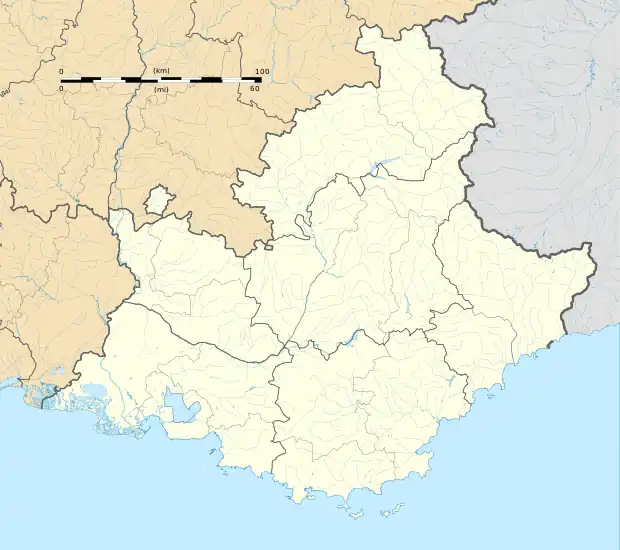Châteauneuf-Grasse
| |
|---|---|
 The clock tower of the church of Saint-Martin in Châteauneuf-Grasse | |
 Coat of arms | |
Location of Châteauneuf-Grasse | |
 Châteauneuf-Grasse  Châteauneuf-Grasse | |
| Coordinates: 43°40′33″N 6°58′32″E / 43.6758°N 6.9756°E | |
| Country | France |
| Region | Provence-Alpes-Côte d'Azur |
| Department | Alpes-Maritimes |
| Arrondissement | Grasse |
| Canton | Valbonne |
| Intercommunality | CA Sophia Antipolis |
| Government | |
| • Mayor (2020–2026) | Emmanuel Delmotte[1] |
| Area 1 | 8.95 km2 (3.46 sq mi) |
| Population | 3,716 |
| • Density | 420/km2 (1,100/sq mi) |
| Time zone | UTC+01:00 (CET) |
| • Summer (DST) | UTC+02:00 (CEST) |
| INSEE/Postal code | 06038 /06740 |
| Elevation | 197–662 m (646–2,172 ft) |
| 1 French Land Register data, which excludes lakes, ponds, glaciers > 1 km2 (0.386 sq mi or 247 acres) and river estuaries. | |
Châteauneuf-Grasse (French: [ʃɑtonœf ɡʁas]; Occitan: Castèunòu de Grassa), alternatively known as names are Châteauneuf de Grasse or simply Châteauneuf, is a commune in the Alpes-Maritimes department in the Provence-Alpes-Côte d'Azur region in Southeastern France.
Châteauneuf-Grasse is situated on the French Riviera, just over 4 km (2.4 mi) from Grasse and 21 km (13 mi) from Cannes; it borders the villages of Plascassier and Opio. It extends across 895 hectares (2,211 acres) and has a population of over 3,600 inhabitants. It is divided into two districts: Pré-du-Lac (where most of the commerce is found) and Le Vignal.
Population
| Year | Pop. | ±% p.a. |
|---|---|---|
| 1968 | 1,278 | — |
| 1975 | 1,602 | +3.28% |
| 1982 | 2,128 | +4.14% |
| 1990 | 2,806 | +3.52% |
| 1999 | 2,968 | +0.63% |
| 2007 | 3,139 | +0.70% |
| 2012 | 3,184 | +0.29% |
| 2017 | 3,505 | +1.94% |
| Source: INSEE[3] | ||
Personalities
- Artist Marina Kulik lives and teaches in Châteauneuf.
- Calouste Gulbenkian lived and is buried in Châteauneuf.
- German actor Anton Diffring and his sister the sculptor Jacqueline Diffring also lived and died in Châteauneuf. He was buried at White Colne in England.
- Harp maker Victor Salvi lived in Châteauneuf for several years.
- Perfumer Jean-Claude de Givenchy lived in Châteauneuf.
- Author Simone Beck lived, and died in Châteauneuf.
See also
References
- ↑ "Répertoire national des élus: les maires" (in French). data.gouv.fr, Plateforme ouverte des données publiques françaises. 13 September 2022.
- ↑ "Populations légales 2021". The National Institute of Statistics and Economic Studies. 28 December 2023.
- ↑ Population en historique depuis 1968, INSEE
External links
- (in French) Châteauneuf official website – general information
Wikimedia Commons has media related to Châteauneuf-Grasse.
This article is issued from Wikipedia. The text is licensed under Creative Commons - Attribution - Sharealike. Additional terms may apply for the media files.